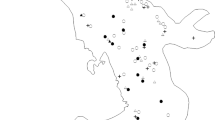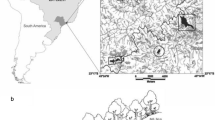Abstract
At Naringal in south-western Victoria, Australia, clearing of the original forest environment has created an agricultural landscape dominated by grazed pastures of introduced grasses. Remnant forest vegetation is re-stricted to small patches of less than 100 ha in size, that are loosely linked by narrow forested strips along road reserves and creeks. Six native and two introduced species of small terrestrial mammal (< 2 kg) occur within this environment. The native mammals, being dependent upon forest vegetation, were less tolerant to forest fragmentation than were the introduced species that also persist in farmland and farm buildings. The native mammals displayed an increasing frequency of occurrence in successively larger size-classes of forest patches. Those species with the greatest body-weight were the most vulnerable to habitat loss. All species of small mammal occurred in narrow habitat corridors of forest vegetation on roadsides. The resident status, seasonal variation in relative abundance, patterns of reproduction, and movements of each species were monitored in two habitat corridors during a 25-month trapping study. The corridors were found to facilitate continuity between otherwise-isolated populations of small mammals in this locality in two ways: firstly, by providing a pathway for the dispersal of single animals between patches; and secondly, by enabling gene flow through populations resident within the corridors. The small size of forest remnants at Naringal, and the vulnerability of species with low population sizes, emphasize the importance of preserving a mosaic of numerous habitat patches that together will support regional populations of sufficient size for longer-term persistence. The continuity between remnant habitats that is provided by a network of habitat corridors is an essential, and critical, component of this conservation strategy.
Similar content being viewed by others
References
Adams, L.W. 1984. Small mammal use of an interstate highway median strip. J. Appl. Ecol. 21: 175–178.
Ambuel, B. and Temple, S.A. 1983. Area-dependent changes in bird communities and vegetation of southern Wisconsin forests. Ecology 64: 1057–1068.
Barnett, J.L., How, R.A. and Humphreys, W.F. 1978. The use of habitat components by small mammals in eastern Australia. Aust. J. Ecol. 3: 277–285.
Bennett, A.F. 1987a. Biogeography and conservation of mammals in a fragmented forest environment in south-western Victoria. Ph.D. Thesis, University of Melbourne, Victoria.
Bennett, A.F. 1987b. Conservation of mammals within a fragmented forest environment: the contributions of insular biogeography and autecology. In: Nature Conservation: The Role of Remnants of Native Vegetation. pp. 41–52. Edited by D.A. Saunders, G.W. Arnold, A.A. Burbidge and A.J.M. Hopkins. Surrey Beatty and Sons, Sydney.
Bennett, A.F. 1988. Roadside vegetation: a habitat for mammals at Naringal, south-western Victoria. Victorian Nat. 105: 106–113.
Braithwaite, R.W. and Lee, A.K. 1979. The ecology of Rattus lutreolus I. A Victorian heathland population. Aust. Wildl. Res. 6: 173–189.
Braithwaite, R.W., Cockburn, A. and Lee, A.K. 1978. Resource partitioning by small mammals in lowland heath communities of south-eastern Australia. Aust. J. Ecol. 3: 423–445.
Breckwoldt, R. 1983. Wildlife in the Home Paddock. Angus and Robertson, Australia.
Campbell, B.H. 1981. An aqueduct as a potential barrier to the movements of small mammals. Southwest. Nat. 26: 84–85.
Diamond, J.M. 1975. The island dilemma: lessons of modern biogeographic studies for the design of natural reserves. Biol. Conserv. 7: 129–146.
Eldridge, J. 1971. Some observations on the dispersion of small mammals in hedgerows. J. Zool. (Lond.) 165: 530–534.
Fahrig, L. and Merriam, G. 1985. Habitat patch connectivity and population survival. Ecology 66: 1762–1768.
Forman, R.T.T. and Godron, M. 1986. Landscape Ecology. J. Wiley and Sons, New York.
Frankel, O.H. and Soulé, M.E. 1981. Conservation and Evolution. Cambridge University Press, Cambridge.
Friend, G.R. 1980. Wildlife conservation and softwood forestry in Australia: some considerations. Aust. For. 43: 217–224.
Gullan, P.K. and Robinson, A.C. 1980. Vegetation and small mammals of a Victorian forest. Aust. Mammal. 3: 87–395.
Henderson, M.T., Merriam, G. and Wegner, J. 1985. Patchy environments and species survival: chipmunks in an agricultural mosaic. Biol. Conserv. 31: 95–105.
Jewell, P.A. 1966. The concept of home range in mammals. Symp. Zool. Soc. Lond. 18: 85–109.
Lewis, T. 1969. The diversity of the insect fauna in a hedgerow and neighbouring fields. J. Appl. Ecol. 6: 453–458.
Lidicker, W.Z. 1975. The role of dispersal in the demography of small mammals. In: Small Mammals: Their Productivity and Population Dynamics, pp. 103–128. Edited by F.B. Golley, K. Petrusewicz and L. Ryszkowski. Cambridge University Press, Cambridge.
Lunney, D. 1983. Bush Rat Rattus fuscipes. In: The Complete Book of Australian Mammals, pp. 443–445. Edited by R. Strahan. Angus and Robertson, Australia.
Mader, H.J. 1984. Animal habitat isolation by roads and agricultural fields. Biol. Conserv. 29: 81–96.
Merriam, H.G. 1984. Connectivity: a fundamental ecological characteristic of landscape pattern. In: Methodology in Landscape Ecological Research and Planning. Vol. 1. pp. 5–15. Edited by J. Brandt and P.A. Agger. Roskilde, Denmark.
Middleton, W.G.D. 1980. Roadside vegetation, a habitat for wildlife. In: Roadsides of Today and Tomorrow. Roadsides Conservation Committee, Victoria.
Noss, R.F. 1987. Corridors in real landscapes: a reply to Simberloff and Cox. Conserv. Biol. 1: 159–164.
Osborne, P. 1984. Bird numbers and habitat characteristics in farmland hedgerows. J. Appl. Ecol. 21: 63–82.
Oxley, D.J., Fenton, M.B. and Carmody, G.R. 1974. The effects of roads on populations of small mammals. J. Appl. Ecol. 11: 51–59.
Pollard, E. and Relton, J. 1970. Hedges. V. A study of small mammals in hedges and cultivated fields. J. Appl. Ecol. 7: 549–557.
Recher, H.F., Shields, J., Kavanagh, R. and Webb, G. 1987. Retaining remnant mature forest for nature conservation at Eden, New South Wales: a review of theory and practice. In: Nature Conservation: The Role of Remnants of Native Vegetation, pp. 177–194. Edited by D.A. Saunders, G.W. Arnold, A.A. Burbidge and A.J.M. Hopkins. Surrey Beatty and Sons, Sydney.
Saunders, D.A. 1980. Food and movements of the short-billed form of the White-tailed Black Cockatoo. Aust. Wildl. Res. 7: 257–269.
Savidge, I.R. 1973. A stream as a barrier to homing in Peromyscus leucopus. J. Mammal. 54: 982–984.
Seebeck, J.H. 1981. Potorous tridactylus (Kerr.) (Marsupialia: Macropodidae): it's distribution, status and habitat preferences in Victoria. Aust. Wildl. Res. 8: 285–306.
Shaffer, M.L. 1981. Minimum population sizes for species conservation. Bioscience 31: 131–134.
Shaffer, M.L. and Samson, F.B. 1985. Population size and extinction: a note on determining critical population sizes. Am. Nat. 125: 144–151.
Simberloff, D. and Cox, J. 1987. Consequences and costs of conservation corridors. Conserv. Biol. 1: 63–71.
Soulé, M.E. and Simberloff, D. 1986. What do genetics and ecology tell us about the design of nature reserves. Biol. Conserv. 35: 19–40.
Suckling, G.C. 1984. Population ecology of the sugar glider, Petaurus breviceps, in a system of fragmented habitats. Aust. Wild. Res. 11: 49–76.
Way, J.M. 1977. Roadside verges and conservation in Britain: a review. Biol. Conserv. 12: 65–74.
Wegner, J.F. and Merriam, G. 1979. Movements by birds and small mammals between a wood and adjoining farmland habitat. J. Appl. Ecol. 16: 349–357.
Willis, E.O. 1974. Populations and local extinctions of birds on Barro Colorado Island, Panama. Ecol. Monogr. 44: 153–169.
Wilson, E.O. and Willis, E.O. 1975. Applied biogeography. In: Ecology and Evolution of Communities. pp. 522–534. Edited by M.L. Cody and J.M. Diamond. Belknap Press, Cambridge, Mass.
Yahner, R.H. 1983a. Small mammals in farmstead shelterbelts: habitat correlates of seasonal abundance and community structure. J. Wildl. Manage. 47: 74–84.
Yahner, R.H. 1983b. Seasonal dynamics, habitat relationships and management of avifauna in farmstead shelterbelts. J. Wildl. Manage. 47: 85–104.
Author information
Authors and Affiliations
Rights and permissions
About this article
Cite this article
Bennett, A.F. Habitat corridors and the conservation of small mammals in a fragmented forest environment. Landscape Ecol 4, 109–122 (1990). https://doi.org/10.1007/BF00132855
Issue Date:
DOI: https://doi.org/10.1007/BF00132855




